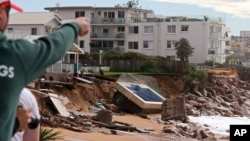At least four people have been killed in wild storms that have struck parts of eastern Australia. Millions of dollars worth of damage has also been inflicted on communities from Queensland to the southern island state of Tasmania.
Parts of New South Wales have had more than 400 millimeters of rain since Friday, and the national capital, Canberra, has recorded its wettest-ever June day.
The storms began in the northern state of Queensland and tore south through New South Wales, where two men died, while another is presumed missing off Bondi Beach in Sydney. A huge and expensive clean-up operation is underway, after many homes were damaged, roads blocked and trees and electricity cables brought down. Hundreds of properties in Sydney are without power. The body of another man was pulled from a swollen river near Canberra.
The assistant police commissioner in New South Wales, Kyle Stewart, said emergency services have been stretched to the limit.
“As at this point in time we have undertaken somewhere in the vicinity of around about 290 flood rescues. Many of those could not have been avoided given the urgency and swiftness with which this event was visited upon the state,” said Stewart.
The dangers on the mainland have largely passed but flood warnings remain, along with evacuation orders, in Tasmania, where the body of an elderly woman has been found. Two men are still missing.
Ferry services from Melbourne to the island state have been suspended.
Prime Minister Malcolm Turnbull is urging people not to cross flooded roads or waterways.
“Do not try to cross flooded roads. Do not try to drive through or travel through flood waters. Stay on high ground and wait for the water to come down. Please,” said Turnbull.
The weather system is known as an east coast low or cyclone that occurs on Australia’s eastern seaboard. About eight of these low-pressure systems typically happen each year, particularly during late autumn and winter.
Some experts doubt that climate change has caused these wild storms off eastern Australia, but they do question what influence higher sea levels caused by global warming may have had on storm surges, and whether record-warm sea temperatures may have fueled the storm’s intensity.
Australia is a land well-used to nature’s extremes, from bushfires to droughts, but the wild conditions experienced in recent days along the heavily populated east coast have taken many by surprise.










